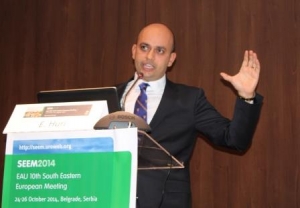 |
| Asso. Prof Emre Huri at the 10th SEEM | Active surveillance in the management of small renal masses offers benefits particularly for elderly patients and those with co-morbidities for which aggressive treatment options are replete with life-threatening risks.
“Active surveillance can be an option in managing small renal masses (SRMS) conservatively with serial imaging, and avoiding the morbidity of surgical or ablative treatment for elderly and/or co-morbid patients with small renal masses and limited life expectancy,” said Asso. Prof. Emre Huri (TR) in his lecture on AS in small renal masses.
Huri gave a lecture during the first day of the 10th South Eastern European Meeting which opened today in Belgrade, Serbia. More than 500 participants gathered in the Serbian capital for a two and half-day meeting where various issues in urology are debated and discussed in plenary sessions, abstract presentations and hands-on training.
Huri added that AS remains a viable option but age, disease stage and co-morbidities are key aspects that need to be carefully examined by doctors.
“Most of these SRMs have a lower malignant potential and are defined as predominantly solid enhancing tumours less than 4 cm in maximal diameter(cT1a),” said Huri.
Current treatment options for SRMs vary and include radical or partial nephrectomy, ablative therapies and active surveillance (observation), according to Huri. He added that the growth rate for SRMs is slow and very few progress to metastatic disease. “Close to 46% of SRMs are benign,” he noted.
“Trials tend to prefer AS instead of surgical treatment in some situations, such as decreased renal function, increased cardiovascular risk, low performance score, complex anatomy and co-morbidity,” said Huri.
|